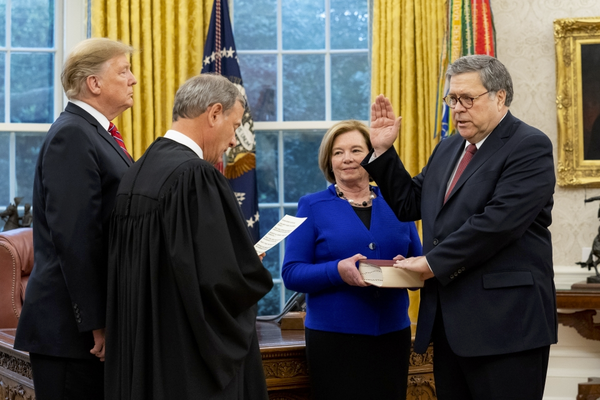William Barr’s Upside-Down Constitution

Attorney General William Barr’s November 15 speech before the Federalist Society, delivered at its annualNational Lawyers Convention,received considerable attention.Barr attackedwhat he views as progressives’ unscrupulous and relentless attacks on President Trump and Senate Democrats’ “abuse of the advice-and-consent process.” Ironies notwithstanding, the core analysis of his speech is a full-throated defense of the Unitary theory of executive power, which purports to be an Originalist view of the Founders’ intent.
This defense, however, reveals the two fundamental flaws of the Unitary view: first, that it is built on a fictional reading of constitutional design; and second, that its precepts attack the fundamental tenets of the checks and balances system that the Founders did create.
Barr’s speech begins with his complaint that presidential power has been weakened in recent decades by the “steady encroachment” of executive powers by the other branches. Even allowing for congressional resurgence in the post-Watergate era of the 1970s, no sane analysis of the Reagan era forward could buttress Barr’s ahistorical claim. Ironically, the presidents in this time period who suffered political reversals—Bill Clinton’s impeachment and the thwarting of Barack Obama’s agenda by congressional Republicans in his final six years of office—nevertheless emerged from their terms with the office intact in powers and prestige.
Attorney General Barr’s reading of colonial history claims that the Founders’ chief antagonist during the Revolutionary period was not the British monarchy (which, he claims, had been “neutered” by this time) but an overbearing Parliament. Had Barr bothered to consult the penultimate statement of American grievances, the Declaration of Independence, Barr would have found the document to direct virtually all of its ire against “the present King of Great Britain.” The lengthy list of grievances detailed in the document charge “He,” George III, with despotism and tyranny, not Parliament (where some of whose members expressed sympathy for the American cause). Barr’s message? Legislatures bad, executives not so much.
Barr insists that by the time of the Constitutional Convention there was “general agreement” on the nature of executive power and that those powers conformed to the Unitary vision—complete and exclusive control over the Executive branch, foreign policy preeminence, and no sharing of powers among the branches. Barr dismisses the idea of inter-branch power-sharing as “mushy thinking.” Yet the essence of checks and balances is power-sharing. As the political scientist Richard Neustadt once noted, the Founders did not create separate institutions with separate powers, but “separate institutions sharing powers.”
And as if to reassure himself and other adherents, Barr insists that the Unitary view is neither “new”—even though it was cooked up in the 1980s by the Meese Justice Department and the Federalist Society—nor a “theory.” Barr says, “It is a description of what the Framers unquestionably did in Article II of the Constitution.” Yet aside from the veto power, he fails to discuss any actual Article II powers. And in the case of the veto, he fails to note that this power is found in Article I, and is generally understood as a legislative power exercised by the executive. Shouldn’t an Originalist take a passing interest in original text? Nor does he explain why Article II is brief and vague, compared to Congress’s lengthy and detailed Article I powers. What we know about that brevity and vagueness is that it reflected two facts: the Founders’ difficulty and disagreement in defining presidential powers, and the wish of a few Founders who favored a strong executive to leave that door open, hoping that future presidents might help solidify the office. That wish, of course, came true.
Most of the latter part of Barr’s speech is devoted to a condemnation of the judiciary, where it has not only set itself up at the “ultimate arbiter” of interbranch disputes, but worse has “usurped Presidential authority” by the very act of hearing cases and ruling against asserted presidential powers. Underlying these complaints are the Unitary tenet that the courts have no rightto rule in any area of claimed executive power. Barr vents his frustration at the extent to which Trump administration decisions and actions have found themselves tied up in court. Experts continue to debate what issues and controversies are or are not justiciable. But to assert by Unitary theory fiat that the courts cannot rule is to make an assertion found nowhere in the Constitution. And Barr also misses the fact that court rulings historically have most often favored executive powers.
The Trump administration’s many questionable actions have raised both new and old concerns about the extent and reach of executive power. There is plenty of blame for abuses of power to spread around, most certainly including to Congress. But the Unitary theory offers no remedy to the power problems of the present era. And the idea that it somehow is an Originalist reading of constitutional powers would be laughable if it didn’t have so many adherents in the seats of power.